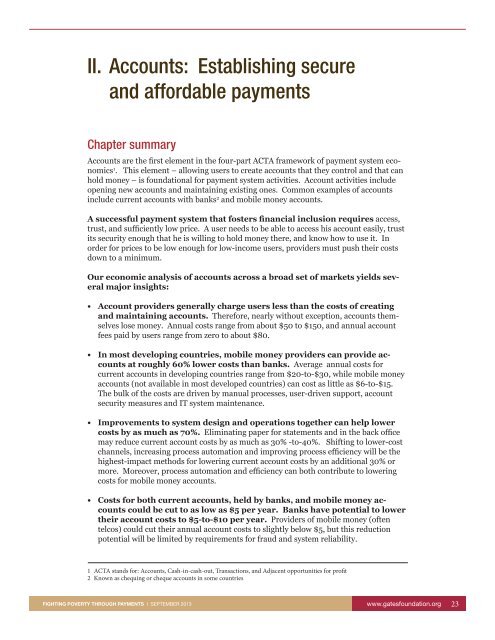Fighting Poverty Profitably Full Report
Fighting Poverty Profitably Full Report
Fighting Poverty Profitably Full Report
You also want an ePaper? Increase the reach of your titles
YUMPU automatically turns print PDFs into web optimized ePapers that Google loves.
II. Accounts: Establishing secure<br />
and affordable payments<br />
Chapter summary<br />
Accounts are the first element in the four-part ACTA framework of payment system economics<br />
1 . This element – allowing users to create accounts that they control and that can<br />
hold money – is foundational for payment system activities. Account activities include<br />
opening new accounts and maintaining existing ones. Common examples of accounts<br />
include current accounts with banks 2 and mobile money accounts.<br />
A successful payment system that fosters financial inclusion requires access,<br />
trust, and sufficiently low price. A user needs to be able to access his account easily, trust<br />
its security enough that he is willing to hold money there, and know how to use it. In<br />
order for prices to be low enough for low-income users, providers must push their costs<br />
down to a minimum.<br />
Our economic analysis of accounts across a broad set of markets yields several<br />
major insights:<br />
• Account providers generally charge users less than the costs of creating<br />
and maintaining accounts. Therefore, nearly without exception, accounts themselves<br />
lose money. Annual costs range from about $50 to $150, and annual account<br />
fees paid by users range from zero to about $80.<br />
• In most developing countries, mobile money providers can provide accounts<br />
at roughly 60% lower costs than banks. Average annual costs for<br />
current accounts in developing countries range from $20-to-$30, while mobile money<br />
accounts (not available in most developed countries) can cost as little as $6-to-$15.<br />
The bulk of the costs are driven by manual processes, user-driven support, account<br />
security measures and IT system maintenance.<br />
• Improvements to system design and operations together can help lower<br />
costs by as much as 70%. Eliminating paper for statements and in the back office<br />
may reduce current account costs by as much as 30% -to-40%. Shifting to lower-cost<br />
channels, increasing process automation and improving process efficiency will be the<br />
highest-impact methods for lowering current account costs by an additional 30% or<br />
more. Moreover, process automation and efficiency can both contribute to lowering<br />
costs for mobile money accounts.<br />
• Costs for both current accounts, held by banks, and mobile money accounts<br />
could be cut to as low as $5 per year. Banks have potential to lower<br />
their account costs to $5-to-$10 per year. Providers of mobile money (often<br />
telcos) could cut their annual account costs to slightly below $5, but this reduction<br />
potential will be limited by requirements for fraud and system reliability.<br />
1 ACTA stands for: Accounts, Cash-in-cash-out, Transactions, and Adjacent opportunities for profit<br />
2 Known as chequing or cheque accounts in some countries<br />
FIGHTING POVERTY THROUGH PAYMENTS I SEPTEMBER 2013 www.gatesfoundation.org 23


